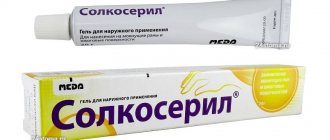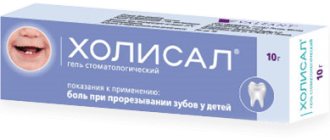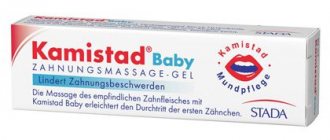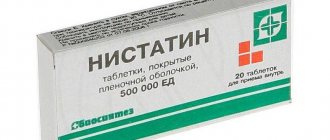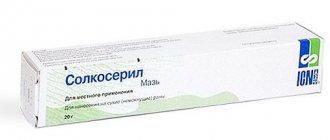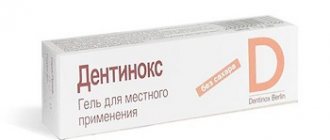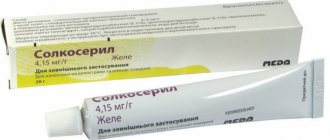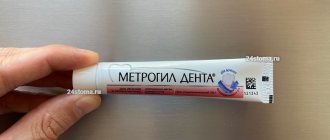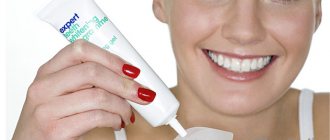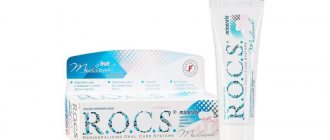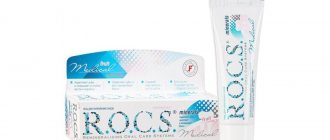It's no secret that pharmaceuticals that are practically not in demand in the West are extremely popular in our country - Corvalol, Zelenka, Mucaltin, etc. Why is this happening? – It is difficult to give a definite answer to this question, due to its versatility.
Today’s material is dedicated to one of these medications – solcoseryl. To be more precise, in the article we will try to answer a question that is relevant for many patients: which is better - solcoseryl ointment or gel, what is the difference between these 2 forms, and how to use the medicine correctly.
What is Solcoseryl ointment used for?
The drug is based on deproteinized dialysate obtained through special processing from the blood of calves. This substance is often used in medicine in countries such as China, Korea, and the entire CIS. It has proven itself to be an effective remedy that can:
- enrich tissue cells damaged due to hypoxia with oxygen and glucose;
- start tissue repair processes;
- activate healthy cell division processes;
- increases the level of energy produced by cells;
- protects the skin from external damage by forming a film on its surface;
- triggers the production of collagen by tissues.
Based on the activity of the drug, the drug can be used for:
- frostbite;
- psoriasis;
- anal ring cracks;
- cuts;
- abrasions;
- scratches;
- bedsores;
- acne marks;
- dermatitis;
First of all, to achieve the best effect, it is necessary to start therapy in the early stages of the problem.
Solcoseryl ointment as a face mask
Cosmetologists claim that the use of Solcoseryl in the early stages of age-related changes allows you to maintain youthful skin. Timely start of use can replace expensive laser rejuvenation in the salon. First of all, Solcoseryl allows you to get rid of wrinkles and prevent their earlier appearance. The ointment is capable of:
- provide adequate nutrition to the facial skin;
- get rid of acne;
- relieve inflammation;
- improve complexion;
- tighten the oval;
- get rid of wrinkles.
The expected effects are possible due to the fact that using a mask allows you to saturate tissues and cells with oxygen and accelerate regeneration. Thanks to the application of the cream, collagen, which is responsible for skin elasticity, begins to be actively produced. The more collagen produced, the fewer wrinkles your skin will have. It is like a support for a heavy skin sheet, preventing its individual areas from falling through, preventing the formation of wrinkles.
Reviews
Lera, 35 years old, Murmansk
Solcoseryl is a regular guest in the home medicine cabinet, because she has verified from her own experience that the ointment effectively eliminates the consequences of thermal burns. The skin recovers very quickly, and no characteristic redness or scars remain on the surface. I plan to use it for wrinkles. Can you share your experience?
Valentina, 43 years old, Stavropol
Lera, don’t even think about applying ointment to your face! Like you, I read a lot of reviews on websites and forums, and then thoroughly treated my nose, forehead, chin and cheeks - all problem areas. I did the mask at night. In the morning the skin was very oily, I had to force it and take a long time to wash it off. My skin dries out around the eyes and around the mouth. I used the ointment for 3 days. When I returned home from work on the 3rd day and took off my makeup, I was simply horrified - my skin had crusted over and became very dry. If you look from the outside, it may seem that you are sick with some serious illness.
Solcoseryl injections: what for
Any surgical intervention is accompanied by a violation of the integrity of the skin and tissues. If the operation involves the removal of some fragment of an internal organ, the body will require a long rehabilitation period, during which the body will be fully or partially restored. Solcoseryl in ampoules can be instantly delivered to tissues, shortening the recovery period. Injections allow you to mobilize all the internal forces of the body to heal wounds, cuts and sutures not only on the outside, but on the internal organs that remain after operations.
Special cases include the prescription of intravenous or intramuscular administration to patients after ophthalmological operations. Solcoseryl ensures active blood circulation, which accelerates the process of adaptation of the organ of vision in the postoperative period, and also reduces the risk of complications.
Instructions for use
In accordance with the instructions for use, solcoseryl ointment and gel are applied only externally in small quantities with an even distribution over the affected area. The gel composition is usually used immediately after injury to the skin, when exudate is released from the damaged capillaries. Ointment is a more effective remedy at the stage of wound epithelization (including for rapid healing of cracks).
Solcoseryl ointment is applied to the affected area in a thin layer 1 to 3 times a day. Instructions for use:
- The wound is carefully treated with an antiseptic.
- The drug is applied to the surface of the affected area.
- To treat a small area of skin, 1 to 2 g of medication is sufficient.
- The composition is evenly distributed over the affected area without further rubbing.
- The procedure is repeated 2 to 3 times a day.
In case of severe lesions, medicinal applications are allowed; if the problem is localized in the facial area, a mask is applied at night. The main advantage of the ointment is the uniform and prompt restoration of the integrity of the skin, without drying out the tissues. No scars are formed at the treatment site.
Indications and contraindications
Solcoseryl ointment and gel are prescribed for the treatment of wounds, restoration and rapid healing of affected areas, and prevention of necrosis. The drug is actively used in complex therapy for severe tissue pathologies.
Indications for prescribing the drug:
- superficial violation of the integrity of the epidermis;
- dry calluses;
- psoriasis;
- fissures in the anus, inflammation of hemorrhoids (in the treatment of hemorrhoids);
- post-acne;
- dermatitis;
- dryness or damage to the nasal mucosa;
- bedsores;
- ulcers.
In some cases, the therapeutic regimen is supplemented with solcoseryl gel (for diseases of the lungs, nasopharynx and throat).
Contraindications:
In accordance with the official data presented in the annotation for the medication, solksoeril does not cause allergic reactions. However, it is contraindicated for use in case of individual intolerance to any ingredient, as well as in case of hypersensitivity of the body to the components of the composition. It is important for pregnant women to consult a doctor first.
Directions for use and doses
Before using the medication, it is necessary to establish the etiology of the disease. Depending on the severity of the pathological process, the doctor prescribes solcoseryl gel or ointment, a suitable dosage and frequency of use of the medicine.
Recommended dosages and methods of applying the medication:
- Thermal skin lesions (grades 2 and 3) - a gel is prescribed at the initial stage. They treat the affected areas up to 3 times a day. The dosage is determined individually. The positive dynamics of therapy is indicated by the formation of a pink layer of skin on the problem area of the skin. At the epithelization stage, the ointment is applied once a day until the wound is completely healed.
- Diabetic foot - an area with a pathological process is treated up to 2 times a day. Duration of therapy is from 1 to 1.5 months.
- Bedsores and trophic ulcers - gel is applied to the pathogenic area, and ointment is applied to the edges. The procedure is carried out 2 times daily. The duration of treatment is 21 days.
- Sunburn - ointment and gel are applied up to 2 times a day. Treatment lasts up to 30 days.
- Scratches and shallow cuts - apply gel to a fresh wound 2 times a day. After epithelization - ointment. Therapy is continued until the integrity of the skin is completely restored.
In dentistry, dental solcoseryl is actively used in the form of a paste. It is used only as prescribed by a doctor. The medication has pronounced analgesic properties. After application to the surface of the mucous membrane or gums, it forms a thin film, which protects the surface from the penetration of potentially unsafe substances.
Side effects and special instructions
It is not recommended to use solcoseryl gel for the face, since it is characterized by an active and direct effect in the area of application. For cosmetic purposes, ointments are preferred because they provide a prolonged effect.
The drug in question does not cause side effects. In case of individual intolerance to the components of the composition, allergic reactions may occur in the form of burning, itching or redness. External manifestations disappear after 10-20 minutes and do not require treatment.
Special instructions:
- The drug is used with caution when using ACE inhibitors, diuretics, and potassium drugs.
- It is important to seek medical attention if side effects occur. The doctor should reconsider the therapeutic regimen.
- The shelf life of the medicine is up to 5 years in a sealed state.
Prescription and withdrawal of a pharmaceutical drug is carried out only by the attending physician. Self-medication can aggravate the course of the disease and cause associated complications.
How to inject Solcoseryl for gastritis
Gastritis is a disease of the gastric mucosa that can occur for various reasons. Solcoseryl ampoules will not become the main drug used in the treatment of gastritis, but it can speed up the healing process, while the prescribed therapy will relieve the patient of the source of the problem.
The gastric mucosa can become inflamed not only as a result of poor nutrition, but also as a result of infection with gastrointestinal infections. The attending physician will first conduct an examination and evaluate the test results, which will allow him to prescribe effective therapy. Solcoseryl will be used as an addition to the main treatment, as it will help the stomach tissues to regenerate faster, ulcers to heal, and inflammation to disappear.
Analogs
Solcoseryl is an imported pharmaceutical product, and therefore the cost is often higher than domestic analogues. Among the available substitutes, the following medications deserve special attention:
- "Redecil" is an external remedy for dermatitis, eczema, psoriasis and skin atrophy.
- "Sagenite" is the best drug for the treatment of degenerative changes and violations of the integrity of the dermis.
- "Actovegin" is a popular substitute for Solcoseryl, prescribed for burns, ulcers and wounds, regardless of their etiology.
The patient must remember that a full-fledged substitute or analogue for a specific disease is prescribed only by the attending physician.
Which is better: Metrogyl Denta or Solcoseryl
Both drugs can be used in the treatment of stomatitis. However, it is better to consider them not as drugs of choice, but from the point of view of a combination of two types of gels. The thing is that stomatitis is most often caused by bacterial infection of the tissues of the oral cavity, which causes the appearance of wounds and ulcers. Metrogyl Denta is an antimicrobial drug with a pronounced antibacterial effect. At the same time, everyone who has encountered stomatitis at least once knows how much one wants to speed up the healing process of ulcers that cause severe pain, especially when eating food. Solcoseryl can force tissue to regenerate as quickly as possible, which ensures prompt healing of wounds.
Which is cheaper: Actovegin or Solcoseryl
Actovegin is a complete analogue of Solcoseryl. Its active ingredient is deproteinized calf blood dialysate. The release forms of Actovegin do not differ from those in which Solcoseryl can be found. Tablets and ampoules for intravenous administration are prescribed for the same indications. Actovegin is a prescription drug, like Solcoseryl. Therefore, they can be considered as the same substance, sold under different names. This means that when one of them is not available in the pharmacy, the pharmacist has every right to offer an analogue as a replacement. However, when comparing price categories, Solcoseryl should be given preference, because its cost is lower than Actovegina.
